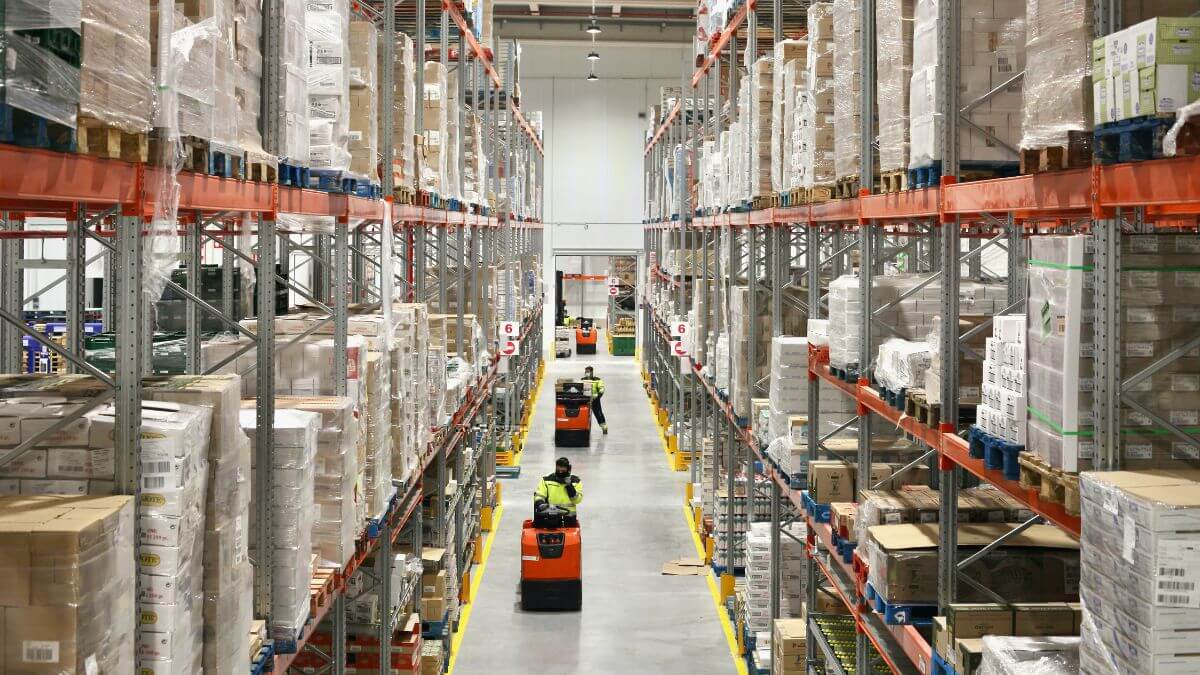Every business wants to grow and succeed. To achieve this, you need to either increase your revenue or cut expenses (ideally, each). One area you can focus on to boost effectiveness is your order-picking operation.
In this article, we’ll look at 12 tips for optimizing picking to reduce the time it takes to travel, improve the accuracy of picking, and eventually make your picks faster in a warehouse.
Why is order selection speed important?
The speed of picking orders is crucial since the longer it takes to select orders and deliver them, the more it will cost your company. This additional time needed to finish your order fulfillment could not only be more expensive at the front, but can also impact the satisfaction of your customers. A decrease in customer satisfaction occurs when a shipping date is not met and the product arrives at a later date, which could lead to the possibility of a loss of future sales.
Luckily, experienced warehouse supervisors have discovered the best practices for order selection and various strategies for picking. These can help reduce the time required for each pick and make it easier to pick your orders. Additionally, these tips are designed to improve not only efficiency but also the accuracy of picking. So, what are the methods to optimize the process of picking orders in your warehouse?
3 Order Picking Warehouse Flow Types
There are three primary types of process flow you need to think about when planning the warehouse ordering process. These are: U-shaped, I-shaped, and L-shaped. The form of the structure and operation define them. You will recognize them by the abbreviation “UIL”. Each comes with advantages and disadvantages, therefore, you need to decide which is the best for you according to your particular items and strategies.
- U-Shaped Order Picking Flow
The flow of picking orders in a U shape has docks inbound and outbound parallel to each other (either adjacent to one another or located on the same side of the warehouse). The product is moved from the inbound dock to storage, staging, packaging, and finally outbound in a U-shape. This is ideal with smaller warehouses. - I-Shaped Order Picking Flow
An I-shaped flow for order picking puts outbound and inbound docks at opposite ends of the warehouse. In this arrangement, inbound materials go to the warehouse on one side to be stored, followed by storage in the middle, then packaging and outbound at the opposite end. Due to its simplicity, it’s great to scale up operations. - L-Shaped Order Picking Flow
The L-shaped flow for order picking is more perpendicular than the U and I-shaped flows. This kind of flow is more uncommon than the other two types, with outbound and inbound typically at a 90-degree angle to each other. The majority of the time, this type is determined by the shape of the building, however, it may help in reducing congestion for order pickers by allowing back and forward traffic.
12 Strategies to Increase Order Picking Speed
Here are the top 12 methods to increase the effectiveness of your ordering strategies. These guidelines might not be applicable to every circumstance, so you’ll be able to determine whether any of the suggestions listed below will work for your specific circumstance or not.
Create a Procedure for Returns Management
It could seem odd to start with the most important step of the chain of supply. But reverse logistics (returns management) is often not considered and can result in significant bottlenecks in a fulfillment process.
Your Warehouse manager or the operations leader should be thinking ahead and pondering how this process is going to take place. In the event that they fail to do so, your returned items could result in a large amount of space, and may require time than needed to fulfill your order.
This could mean establishing the area and division accountable for the examination return of orders. Most often, businesses give returned orders to an individual category. These classes will designate particular items for repair, restocking, or removal. If you don’t have a procedure for sorting, your inventory of returns will be stacked, and you will not be able to make the most of the inventory. This is even more work than it typically will, if there isn’t an established process for returns.
Select the Appropriate Picking Method
There are four primary methods of choosing strategies that are employed to pick items in fulfillment center warehouses. They are the traditional pick-and-place batch picking, zone picking, and wave-picking.
Each of these methods has its own advantages and drawbacks. It all depends on the kind and amount of SKUs, as well as the size of the warehouse overall. To boost the efficiency of your pick, it is important to study the most effective techniques for each strategy and then determine which is most suitable for your specific company.
Certain warehouses (including our own) employ multiple variants and combinations of strategies. At AMS, we choose our approach in a way that is distinct for each customer, and sometimes according to the project. We usually implement an approach based on what the most efficient and exact process is for the particular customer.
Get Out of Piece Picking
Piece picking is a great option for smaller warehouses that have a smaller number of SKUs. But, when the order increases, demand for picking increases, either in volume or by the quantity of SKUs, the piece-picking strategy becomes less effective.
Sometimes, your client may just be dictating this because of the requirement for speedier fulfillment of orders, which is triggered by the quicker method of picking orders.
Emphasis on Facility Flow in Warehouse Layout
The main factor in reducing the efficiency of any order picking method is the amount of distance traveled by any picker within the warehouse. If the picker has to travel far distances to select the items needed to fulfill an order, the time spent traveling decreases the speed of picking.
Your warehouse pickers’ logical flow
To maximize this, think about planning the storage layout in accordance with the normal routes your pickers have already taken. If you look at your layout and there are any inventory areas that are slow to move within close proximity to picking stations or packing areas, there is an opportunity to immediately improve the efficiency of your operation.
Each zone should move to the next step of the selection process. The flow of traffic should be in the same direction, thereby reducing the amount of traffic for your order-picking teams.
Of course, you must take this into consideration with the design of your building. Take a look at the 3 kinds of layouts that were mentioned previously in the article.
Maintain Clear Warehouse Aisles
Inconvenient aisles that are cluttered with garbage that is not organized can hinder the speedy order-picking process. This is due to the fact that it is not just taking longer to navigate through the clutter, but also creates traffic congestion because there is less space within the aisle.
Instead of letting trash pile up, create an ongoing process to organize inventory or clear garbage before it causes problems.
Make sure your warehouse has a staging area.
It’s tempting to make use of every square foot in your storage facility. In the end, every square foot is a cost to you ,isn’t it? It’s true, but an unorganized warehouse that has no “incidental” space may suffer from massive congestion problems. It can occur when inventory has to be moved or there is an abrupt increase in materials coming in.
Another issue with not having a staging space within your warehouse is that your inclination will be to not improve the layout of your warehouse or the locations of your inventory. Because without a staging space, the effort required to achieve even tiny improvements in process and efficiency of orders is much more time-consuming that it is worth.
The small staging space permits the flexibility to operate a more efficient warehouse and order-picking operation.
Selecting the Best Type of Strategy for Layout Flow
One method to assist with the process is to employ another method of choosing. For instance, zone picking allows an order picker to concentrate on only items at their location within the warehouse. This allows them to select items quicker and more accurately than the case if they had to travel across the whole warehouse.
Additional Advice on Dividing Well-Known Items
Create an A-list which includes items that are frequently purchased. Check where they are in the warehouse. You may also consider more convenient locations for other steps of the pick-up and shipping process.
Organize Inventory Correctly
Simple organization is an effective way to increase the speed of picking for warehouse employees. This is true for every business. Inefficiently arranged storage, mis-marked pallets and inventory stored haphazardly in a variety of locations all add to the amount of time needed for completing orders.
Unless somebody is able to fix the poor inventory management the business will suffer as time passes when the issue becomes worse. The rate of picking will drop as well, and everyone hates searching for a product, therefore morale of employees could be affected.
And, not only that, you could also see shrinkage in inventory from items that are that are stored in improper areas. This can be sold into waste due to storage areas that are not properly organized.
Making sure you incorporate proper categorization, tracking and management of locations to your business plan will stop these time and money problems from ever coming up.
Make Use of Bins and Other Containers
Smaller items can be organized. placing the items in their own sort of bin will help the organization. Consider the time it takes to select the item. If your team of pickers has to take a pallet and go through a box to find an item, transferring the storage into bins once they’re opened can dramatically decrease the time for picking.
You can also organize your things with recyclable plastic bags and separators. This will allow you to organize and store bulk quantities comprising tiny bits of material, such as nail washers, O-rings etc.–while offering you the ability to put the rest of your items in the exact same place on the shelf. If properly labeled, the containers and partitions make it easier to search for items and also help to keep the contents clean of dust.
Enhance the Ergonomics of Warehouse Picking
Sometimes, warehouses are guilty of putting things either up on a display, or in the ground. This is not just a way to increase the time it takes to pick the item, but it also increases the chance of injuries or accidents.
Moving the most frequently picked items to a standard standing height reduces the risk of injury as well as the additional time needed to climb ladders and crawl across the ground. It also enhances the satisfaction of your team’s workers because of less work requirements.
You could also install an inventory picking equipment to use in your warehouse. This can help to make picking more efficient and safer for employees.
Pick and Pack in a Single Step
One of the most effective ways to increase the speed of your pack and pick is to incorporate packing and picking in the same procedure. Traditional pick and pack involves the picker carrying selected items from the warehouse and then to the packaging station.
Instead of doing it with two separate steps you might consider placing items in their shipping containers when you select items from your shelves or storage bins. Of of course, this isn’t an option for all pick strategies or businesses. But, if it’s feasible with your fulfillment method, it will help you save time and improve the efficiency of picking.
Create Effective Stock Management Procedures
In the event of an inventory shortage, it isn’t just a concern for purchasing and sales teams. It also impacts the efficiency of order pick operations. One reason could be because the space that is devoted for this stock is not used and could be utilized to make another item.
If this item is among your top operating SKUs, then your stock location is more valuable for the efficiency of your selection. If it’s out of stock, customers must move over the open slot for other items on the order. In the event that it did have a place in inventory alternative products could be used to fill the space for that item to allow the picking process to be more efficient.
The best practices for managing inventory include establishing a replenishment plan for all stocks. There are two methods for this: cycle stock and cushion (or security) stocks. Implementing a solid warehouse management system will also help to prevent stock shortages.
Create a Receiving Procedure
Like ensuring your reverse logistics strategy is implemented, the same is the case for receiving. This is often neglected in warehouses, with managers thinking that it is best to wait until the warehouse is actually receiving the inventory.
In the absence of this process, it can lead to severe problems and extremely long lead times for the inbound material. Not just long lead times, but also the possibility of shrinking inventory or loss can be a definite possibility when there is no process for receiving can be in operation.
A well-organized receiving procedure must have a basic staging area and a system for categorizing and putting material that is received into the software for managing warehouses. Some warehouse workers should be focused on this process and not distracted by other duties.
Make Use of the Right Warehouse Equipment
You may implement the strategies and best practices to improve your fulfillment process however, if you don’t have the right equipment, it won’t be efficient.
For instance, mobile-picking technology like RF scanners are great however they are not able to help a messy warehouse. But, when the fundamental elements are in place, the proper equipment can improve efficiency in leaps and leaps and.
Some improvements to warehouse equipment could be:
- RF Inventory Scanners
- Conveyer Systems
- Sorting Systems
- Pick to Light Systems
- Automated Storage Retrieval Systems
- Forklifts
- Step Ladders
- High-density Racking
The primary reason for investing in new equipment must be two aspects that are time and safety. Sometimes, equipment won’t improve the process of picking efficient, but it will make it more secure. The investment should be weighed equally with alternatives to save time.
Stop picking on paper and switch to a warehouse management system (WMS)
The implementation of a warehouse management program can improve productivity as well as order accuracy. It’s not just that, but the WMS system can open up the possibility of more complicated fulfillment strategies like wave-picking and other combinations of picking.
A WMS also allows managers to keep an current and real-time information about the status of their inventory and line status. This is crucial for enhancing in efficiency. Not only does the WMS aid in the organization of current pick strategies, but it can also demonstrate other areas that could be improved and efficiency.
Additionally the WMS can also allow some automation by carrying out tasks like making list of picks, processing orders or shipping orders, as well as creating a set of warehouse workers’ picks. This, in itself, will make fulfillment faster since an individual is no longer needed to complete this task.
Put Bundling and Kitting into Practice
Customers often purchase specific products frequently. Your warehouse team could implement an assembly procedure to bundle the products prior to their arrival in your inventory. This process is known as ” kitting”. This means that your staff will not need to handle the selection and assembling of the different products at the time that the purchase is made. This reduces time and improves the accuracy of each order.
The disadvantage is that you have to have confidence that your customers will keep purchasing this way in the near future. If not, your kitted SKUs can take up area in the inventory. The process of picking orders will take longer and you might be required to disassemble the kits at some point in the future.
Take Seasonality Into Account Before It’s Too Late
Don’t delay too long to anticipate the seasonality of your order volumes. If your customers usually purchase more at Christmas or any other time your sales and marketing staff must be aware of this.
Then, it’s the matter of connecting your marketing and sales teams to your warehouse and operation managers. Together, they’ll be able to create the layout, labor and process strategy to effectively manage the shifts in orders during the season. fulfillment.
Conclusion on Choosing Best Practices
I hope these optimization strategies can help you figure out how to select quicker in a warehouse. The process of fulfillment for orders in your warehouse could be the difference between success or failure for your company. Be aware that the method to increase your profits isn’t always about increasing sales. Cost reduction is an important factor. The strategies you employ to pick and the efficiency of warehouse orders can help in this regard.




